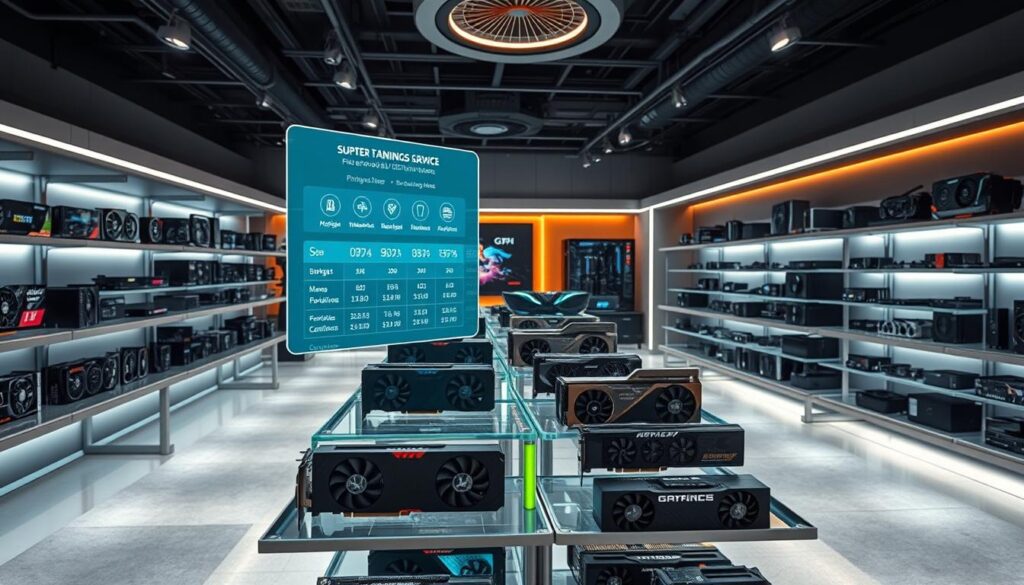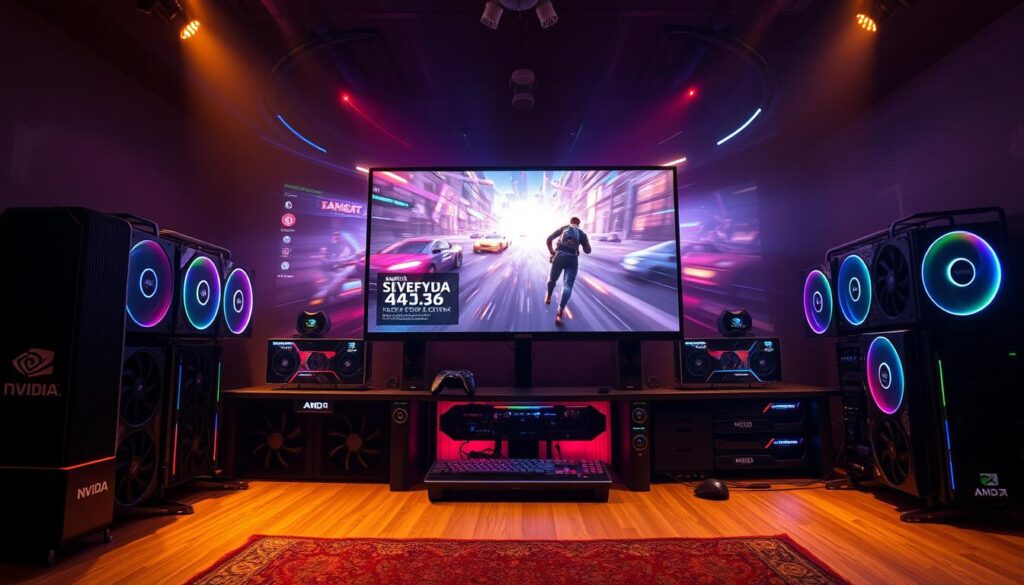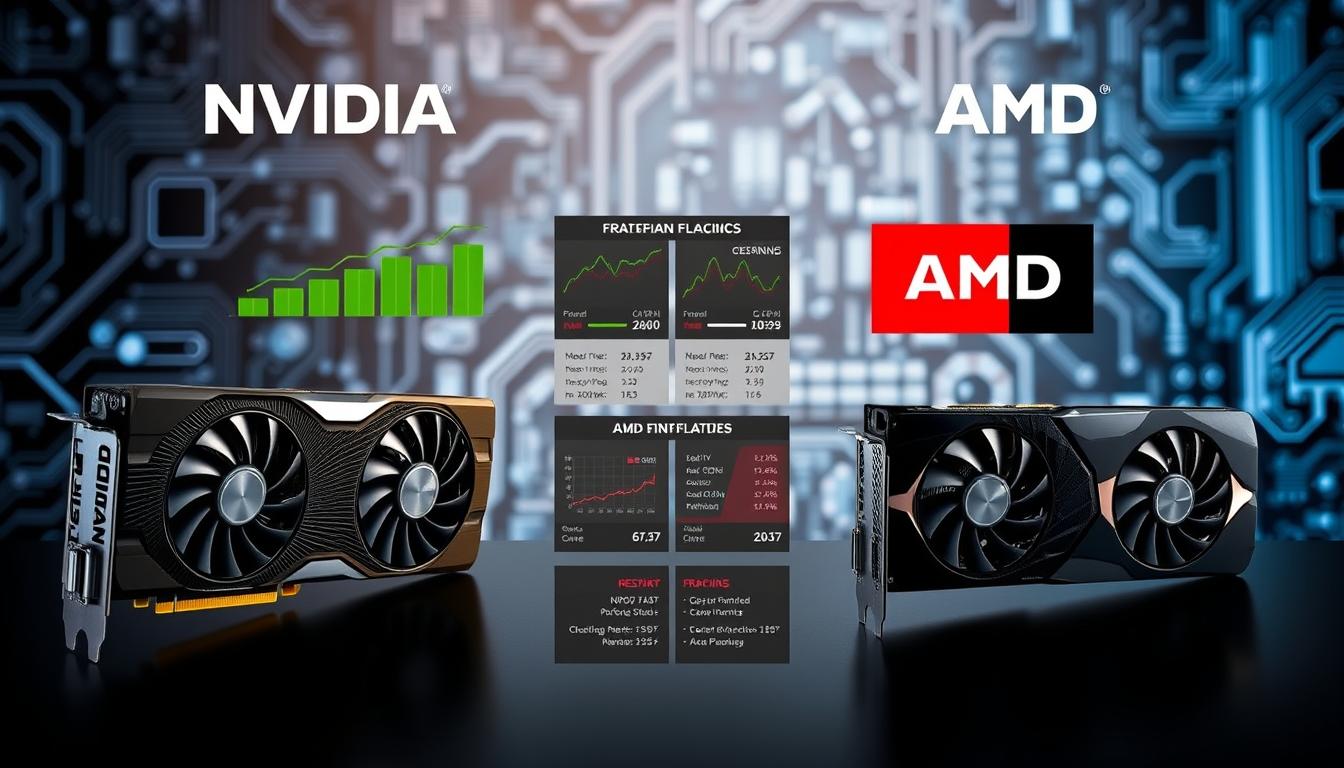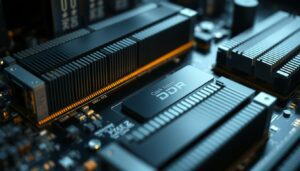NVIDIA or AMD graphics cards. Selecting the best graphics card might be like negotiating a technological minefield. Both firms are pushing the edge to give top-tier performance in the face of fierce competition in the GPU business. Knowing the nuances of these cards is vital, whether of whether you’re a skilled creator or an enthusiastic gamer.
With their complicated capabilities like AI-driven upscaling and ray tracing, current GPUs are totally transforming the way we play games and work on creative projects. There are various choices, ranging from top-tier models like the GeForce RTX 4090 to new Radeon options. But which one works best for you?
To help you in making an informed choice, this book looks closely into software features, pricing, and performance data. We can help you whether you’re building a setup that will last or you’re on a limited budget. Let’s discover your ideal mate by digging into the universe of graphic cards!
Understanding the GPU Market and the Battle Between Nvidia and AMD
Since its inception, graphics technology has advanced significantly. The development of GPUs from simple rendering to sophisticated AI-driven capabilities has been nothing short of amazing. Two titans currently control the market, each with a distinct strategy for price and innovation.
Evolution of GPU Technology
GPUs were initially intended for straightforward applications like 2D picture rendering. They developed over time to manage intricate 3D images, transforming the creative and gaming sectors. A significant turning point in GPU history was the advent of parallel processing and programmable shaders.
Advanced designs like RDNA and Ada Lovelace are now found in modern GPUs. The goal of these designs is to lower power consumption while increasing performance. New ideas like ray AI upscaling and tracing have greatly increased the capabilities of GPUs.
Current Market Trends and Innovations
Advanced technologies are driving the GPU market. Once a specialty feature, ray tracing is now commonplace in expensive cards. By simulating realistic lighting, this technique improves visual fidelity in applications and games.
AI-powered features like FSR and DLSS are also becoming more popular. These solutions promise smoother speed without losing clarity by upscaling lower-resolution pictures using machine learning. Furthermore, the introduction of AI into GPUs is offering new opportunities in sectors such as machine learning and data science.
“The GPU business today acts as a platform for innovation in a range of industries, not merely gaming.”
Strategies for pricing have also changed. Although high-end cards deliver unparalleled performance, low-cost solutions offer great value for occasional users. Important turning points in GPU evolution are highlighted in the table below:
| Year | Milestone | Impact |
|---|---|---|
| 1999 | Introduction of programmable shaders | Enabled complex 3D rendering |
| 2018 | Ray tracing debut | Revolutionized lighting in games |
| 2022 | AI upscaling technologies | Improved performance and visuals |
The objective of finding a balance between and performance remains important because the GPU industry expands. Identifying these trends can assist you in making an informed decision, regardless of your level of experience.
NVidia or AMD: A Thorough Examination of Graphics Cards
Selecting the best graphic cards might be difficult. Although both companies provide state-of-the-art technology, their strategies are very different. To assist you in making an informed decision, this section deconstructs software ecosystems, features, and performance indicators.
Performance Metrics and Benchmark Insights
Mainstream models dominate the market such as the AMD Radeon cards and the RTX 4090 in terms of raw power. According to benchmarks, the RTX 4090 performs incredibly well in 4K games, delivering over 100 frames per second in challenging titles. AMD’s high-end products, meanwhile, offer competitive results at slightly lower rates.
Another key distinction is ray tracing performance. Because Nvidia’s GPUs feature specialized RT cores, they frequently do better in this area. AMD plugs the gap, though, with its FidelityFX Super Resolution (FSR) technology, It increases ray-traced game frame rates without sacrificing the quality of the image.
Features and Software Ecosystem Overview
Ecosystems of software are vital to the complete experience. To offer more seamless gaming, Nvidia’s Deep Learning Super Sampling (DLSS) enhances lower-resolution images with AI. In AMD’s FSR is compatible in contrast with a larger device count and is open-source.
Strong driver support is offered by both brands, providing compatibility with the newest apps and games. While AMD’s Adrenalin software emphasizes on personalization and performance tuning, Nvidia’s GeForce Experience offers other skills including game optimization and streaming tools.
“The way a GPU improves your experience is more important than its raw power.”
A brief comparison of important performance indicators is provided here:
| The feature | Nvidia RTX 4090 | AMD Radeon RX 7900 XTX |
|---|---|---|
| Performance of 4K Gaming | 120 FPS | 110 FPS |
| Performance of Ray Tracing | Excellent | Good |
| Technology Upscaling | DLSS | FSR |
Recognizing these distinctions can assist you in selecting the best graphics card for your needs, regardless of your degree of experience, a player or a content producer. From luxury powerhouses to more affordable substitutes, the market has something for everyone.
Price and Value: Comparing Premium, Midrange, and Budget Options
Pricing is a big decision factor when it comes to GPUs. Knowing how to balance pricing and performance is important whether or not you’re a gamer, content provider, or casual consumer. The market provides a large assortment of solutions to fit varied needs and price ranges, ranging from more affordable to more expensive powerhouses.

High-End Price Analysis
Models that are flagships dominate the high-end market and high-end GPUs, such as the RTX 4090. These cards are ideal because of their unmatched performance for demanding creative 4K gaming and work. They can also have expensive costs, often exceeding $1,500.
The RTX 4070 offers a more comprehensive option For those seeking superior performance. For gamers, it’s a wonderful buy at around $600 those that aim for high frame rates without actually over budget. The luxury market is very competitive since competing companies offer similar results at slightly cheaper prices.
Value Propositions and Cost-Effective Options
Customers with limited funds and low-cost GPUs will be advantageous for casual players. like the RTX 4060. At a reasonable price of roughly $300, these cards offer sufficient functionality for everyday chores and 1080p video games. They offer exceptional value for the money, even if they lack advanced capabilities like ray tracing.
Budget and high-end GPUs are separated by midrange alternatives. For gamers who desire good performance without going over budget, models like the RTX 4070 offer a sweet spot. These cards are a great way to ensure that your setup is future-proof because they often possess features such as AI upscaling.
“Selecting the ideal GPU requires striking the ideal balance between price and performance, not just raw power.”
Here is a brief comparison of well-known models and their costs:
| Model | Price | Target Audience |
|---|---|---|
| RTX 4090 | $1,599 | Professionals and enthusiasts |
| RTX 4070 | $599 | Gamers in the middle |
| RTX 4060 | $299 | Users on a tight budget |
The decision ultimately boils down to your demands and financial limits. Understanding the worth proposal assurances you maximize the value of your purchase, if you’re trying to find for a luxury card or a more affordable one.
Performance and Gaming Experience: 4K, 1440p, and 1080p Insights
With every resolution from 4K to 1080p, offers both benefits and drawbacks in terms of performance. It is essential to comprehend how your graphics card works responds to various resolutions, if you wish to maximize for enhanced fluidity or the highest possible settings gameplay. To assist you in choosing the best option let’s go over the details of your gaming setup.

4K and Ultra Settings Performance
4K gaming with extreme settings is the best option for gamers looking for the best possible visual experience. Here, high-end cards shine, producing breathtaking images and fluid frame rates. Modern features like as DLSS and FSR are crucial for increasing production without sacrificing quality.
According to benchmarks, luxury models capable of running demanding 4K games at around 100 frames per second. Due to the unique ray tracing hardware of the GPUs, realistic shadows and lighting. However, obtaining this level of performance usually comes at a higher cost.
Midrange and Budget Gaming Comparisons
Budget-friendly and midrange cards still provide tremendous worth if you have a limited budget. These substitutes do well in the vast majority of recent games and are ideal for 1440p and 1080p gaming. Even at reduced resolutions, they provide a flawless experience though 4K high settings might be too much for them to handle.
Midrange GPUs frequently come with software upgrades like AI upscaling, which enhances frame rates without losing visual quality. Conversely, reasonably priced options are appropriate for casual gamers that emphasize economy over cutting-edge capabilities.
“The right resolution and settings can drastically change the way you play games, even if money is tight.”
A brief comparison of well-liked resolutions and their qualifications are listed below:
- 4K: Best suited for expensive GPUs, which provide fluid gameplay and breathtaking graphics.
- 1440p: A sweet spot for midrange cards that strikes a balance between aesthetics and performance.
- 1080p: Perfect for low-cost choices, offering good performance for light gaming.
Regardless of how tight your budget or acquiring a luxury one, deciding on the appropriate settings and resolution guarantees that your graphics are optimized card’s performance.
Special Features and Support for Software: Ray Tracing, DLSS, and More
NVIDIA or AMD graphics cards. The unique capabilities of modern GPUs redefine performance and visual quality. These technology is changing the way that games and creative processes work in the future. Among these is upscaling driven by AI and complex ray tracing. Let’s look at how these developments open the door to a better user experience.
Advanced Ray Tracing Capabilities
The GPU market has evolved because of the Ray Tracing. This method produces visually aesthetically pleasing pictures by mimicking natural lighting, shadows, and reflections captivating images. In this sense, high-end GPUs are better since of their specialized gear for ray tracing in real time.
In relation to ray tracing, some manufacturers have achieved notable progress, while others are catching up. This feature is beneficial since it can enhance gameplay and professional applications. For gamers, it makes video games seem more cinematic. It ensures that 3D projects are rendered correctly for creators.
Upscaling Technologies: DLSS vs. FSR
In the GPU market, AI-powered upscaling is another victor. Machine learning is used by DLSS, or Deep Learning Super Sampling, to upscale lower-resolution photos for smoother performance without losing quality. 4K gaming benefits immensely from this feature.
However, FSR (FidelityFX Super Resolution) is an open-source substitute that is compatible with a larger variety of devices. For users with midrange or budget cards, it provides great value even though its performance might not approach that of DLSS. Both technologies are necessary for contemporary gaming since they seek to improve frame rates and visual fidelity.
Driver Quality and Software Enhancements
Software ecosystems and driver support are essential components of the whole experience. Adaptability to the most recent applications and games is maintained by periodic upgrades. In addition to enhancing efficiency, high-quality drivers lessen stuttering and mishaps.
Additional value is added by software improvements like performance tuning tools and game optimization tools. Whether playing games or working on artistic endeavors, these options let users personalize their experience. When selecting a GPU, professionals may consider strong software support to be a determining factor.
“The software and features that improve your experience are equally as important as the hardware when choosing a GPU.”
Here is a quick comparison of the key characteristics:
- Ray Tracing: For captivating images, use realistic lighting and shadows.
- DLSS: Upscaling powered by AI for more fluid performance.
- FSR: Open-source upscaling for broader compatibility.
- Driver Support: Regular updates and optimization tools.
These unique aspects may affect your choice, regardless of your level of gaming experience. You may select the ideal alternative for your needs and budget by being aware of its advantages.
A Glimpse Into Future Trends in GPU Technology
GPU technology is expected to have a revolutionary future. The next generation of GPUs promises to revolutionize the user experience with its quick architectural, AI integration, and energy efficiency breakthroughs. These developments will create new opportunities whether you’re a professional, player, or maker.
New trends will push the limits of performance while addressing existing constraints. Delivering greater value without sacrificing quality is the goal, from improved AI capabilities to more intelligent power management. Let’s examine what GPU technology has in store.
Innovations in GPU Architectures
It is anticipated that next-generation GPUs will have more effective architectures. Performance per watt will be given top priority in these designs, which makes them perfect for both portable and high-end devices. Efficiency will be further improved by fewer manufacturing nodes and sophisticated cooling systems.
Future GPUs will be more heavily reliant on AI-driven capabilities. AI will enhance performance in professional and gaming apps through intelligent workload management and real-time rendering. By automating difficult activities, this integration will also enhance the user experience.
Market Shifts and Competitive Dynamics
Innovation is being propelled by the rivalry between top brands. The distinctions between their products may become more hazy if both businesses improve their approaches. Customers may be able to choose from more reasonably priced high-performance solutions as a result.
Market trends for the future point to an emphasis on sustainability. Priority will be given to GPUs that use less energy while still delivering great performance. This change is in line with consumers’ increasing desire for environmentally friendly technology.
Enhanced Upscaling and Driver Support
Upscaling technologies like as FSR and DLSS will keep developing. These tools are crucial for 4K gaming and beyond since they will provide even higher performance and visual quality. Additionally, improved device compatibility will improve the user experience.
Support for drivers will continue to be a crucial distinction. Applications will run smoothly with regular updates and optimization tools. The benchmark for upcoming GPUs will be established by this dedication to software excellence.
“The key to the future of GPUs is striking a balance between accessibility and innovation so that every user has the best possible experience.”
A brief overview of expected developments in GPU technology is provided below:
| Trend | Impact |
|---|---|
| AI Integration | Optimized performance and automation |
| Energy Efficiency | Reduced power consumption and heat |
| Enhanced Upscaling | Better visuals and smoother gameplay |
| Driver Support | Improved compatibility and stability |
Users may anticipate a smooth fusion of performance, efficiency, and innovation as GPU technology advances. These developments will raise the bar for the sector and redefine what is feasible.
Final Thoughts NVIDIA or AMD graphics cards
Budget, features, and performance must all be balanced when choosing a graphics card. From the competitive edge of the 7900 XTX to the raw power of the GeForce RTX 4090, this article has examined the advantages of both top brands. There is a card for everyone, whether you are a professional creative or a gamer.
Your choice is heavily influenced by pricing, performance metrics, and premium features like AI upscaling and driver assistance. While more affordable versions offer great value for casual users, high-end models perform exceptionally well in demanding workloads and 4K gaming. Brand competition guarantees innovation, providing each user with state-of-the-art technology.
In the end, your decision should be in line with your priorities. The GeForce RTX series stands out for superior performance. Other choices like the 7900 XTX are appealing because of their cost-effectiveness and flexibility. Whichever choice you choose, you’re putting dollars in an a treatment that will increase your expertise and endure into the future.
FAQ
What makes something pricey graphics cards made by inexpensive?
Expensive cards, like the RTX 4090, improve the performance of 4K gaming and ray tracing, however, budget cards, like the RTX 4060, put affordability first for 1080p gaming.
What does ray tracing entail, and How do advancements in technology effect video games?
FSR and DLSS are two instances of technology that are scaling up that enhances frame rates without compromising on quality, ray tracing, however, gives intricate lighting.
Which brand offers better driver support?
Both companies offer reliable driver updates, but NVIDIA frequently takes the lead in optimizing new features and games.
Are expensive GPUs worth the money spent?
Exceptional GPUs such as the RTX 4080 and Radeon 7900 XTX excel at demanding occupations and 4K video games.
Which choice is ideal for gaming in the midrange?
Cards such as RTX 4070 find equilibrium between cost and effectiveness, making them ideal for gaming in 1440p.
How does competition benefit gamers?
Competition is what spurs innovation, It leads to further features, reduced costs and better market results.
What ought to be my top priority when purchasing a GPU?
Take your spending limit and gaming resolution into account, and desired features to determine the optimum fit, such as upscaling or ray tracing.
How does software brands have different ecosystems?
The Radeon software from AMD and the NVIDIA GeForce Experience provides helpful resources, however NVIDIA continuously performs better than in special features like DLSS.






